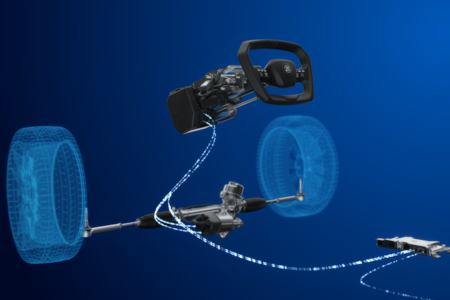Nissan has revealed its steer-by-wire technology, which allows independent control of a vehicle’s tire angle and steering inputs, replacing the conventional mechanical steering system. The system reads the driver’s intentions from steering inputs and controls the vehicle’s tire movements via electronic signals. This transmits the driver’s intentions to the wheels even faster than a mechanical system.
The system is also said to control and insulate the vehicle from unnecessary road-generated disturbances to deliver only the necessary performance feel to the driver. For example, on a road surface with minor ridges or furrows, the driver no longer has to grip the steering wheel tightly and make detailed adjustments, so traveling on the intended path becomes easier.
The technology is claimed to be highly reliable thanks to multiple ECUs. In the event of a single ECU malfunctioning, another ECU will instantly take control, and in extreme circumstances such as the power supply being disrupted, the backup clutch will act to connect the steering wheel and wheels mechanically, ensuring continued safe travel.
Accompanying this steering technology, Nissan has also developed a camera-based straight-line stability system to further enhance on-center driving capability. The system improves vehicle stability by making small input angle adjustments so the vehicle will accurately trace and continue as planned in the lane it is traveling. If the vehicle direction changes due to road surface or crosswinds, the system acts to minimize the effect of these conditions resulting in reduced steering input from the driver.
Using a camera mounted above the vehicle’s rearview mirror, the system analyzes the road ahead and transmits this information to multiple electronic control units as electronic signals.
The steer-by-wire technology will be fitted to selected Infiniti models on sale within the next year.




